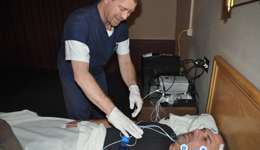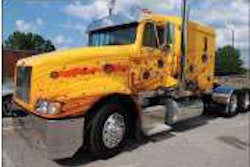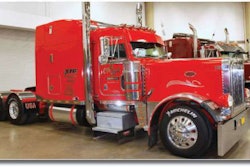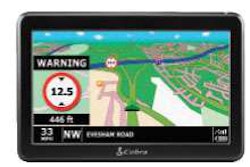 A technican for Sleep Pointe at Prime Inc.'s off-site sleep lab in Springfield, Mo., shows how he readies a patient for sleep apnea testing. (Photo Randy Grider)
A technican for Sleep Pointe at Prime Inc.'s off-site sleep lab in Springfield, Mo., shows how he readies a patient for sleep apnea testing. (Photo Randy Grider)The National Transportation Safety Board wants the Federal Motor Carrier Safety Administration to begin a program to identify commercial drivers at high risk for obstructive sleep apnea, and if treatment is required, show that it is has been conducted.
The NTSB also issued these recommendations to the Federal Transit Administration and the Federal Aviation Administration. It’s now up to the Coast Guard to ensure these operators are screened, evaluated and treated for obstructive sleep apnea (OSA).
On Oct. 20, the board issued the recommendation for commercial drivers, noting “relative risk of accident involvement for individuals with OSA is clearly elevated and quite clearly associated with the untreated disease.” The FMCSA’s research suggests at least 10 percent of commercial drivers have at least moderate OSA.
The NTSB wants the agency to identify these drivers and show, when necessary, they are effectively treated through the medical certification process of evaluation, before being granted unrestricted medical certification.
“Commercial motor vehicle drivers at risk for obstructive sleep apnea is a safety issue we take seriously,” said FMCSA spokesman Duane DeBruyne. “The Federal Motor Carrier Safety Administration is already considering a rule to tighten its standards for medical certification of commercial drivers.”
The FMCSA has a question on its medical certification that asks about sleep disorders. It also offers this under “Is Sleep Apnea Disqualifying?”
“Drivers should be disqualified until the diagnosis of sleep apnea has been ruled out or has been treated successfully,” and “A driver with a diagnosis of (probable) sleep apnea or a driver who has Excessive Daytime Somnolence should be temporarily disqualified.”
Last year, the FMCSA Medical Review Board recommended the FMCSA require screening for OSA for drivers with a Body Mass Index over 30, but the agency has not acted on this.
The NTSB also wants the FMCSA to develop and disseminate guidance for commercial drivers, employers and physicians regarding the identification and treatment of individuals at high risk for OSA.
The Owner-Operator Independent Drivers Association has said on its website that OSA has almost always been linked only anecdotally to some crashes. Drivers should be able to freely discuss medical conditions with physicians without damaging their career or causing them unnecessary medical expense, OOIDA said.
“The industry knows apnea is a problem and many companies have their own apnea screening and treatment programs,” said Clayton Boyce, American Trucking Associations spokesman. “Also the current FMCSA required medical screening process includes checks for apnea.”









